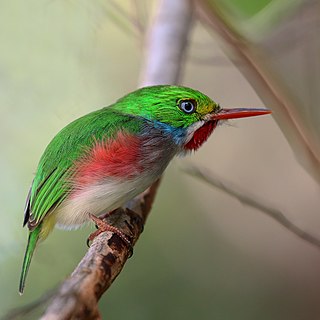
The todies are a family, Todidae, of tiny Caribbean birds in the order Coraciiformes, which also includes the kingfishers, bee-eaters and rollers. The family has one living genus, Todus, and one genus known from the fossil record, Palaeotodus.

The yellow-billed blue-magpie , or gold-billed magpie, is a passerine bird in the family Corvidae, along with crows and jays. It forms a superspecies with the Taiwan blue magpie and the red-billed blue magpie. The species' range covers the northern parts of the Indian Subcontinent, including the lower Himalayan foothills, with a disjunct population in Vietnam.
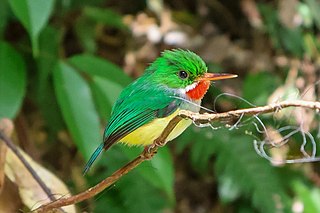
The Puerto Rican tody, locally known in Spanish as San Pedrito, is a bird endemic to the main island of Puerto Rico. In 2022, the tody was approved as the official national bird of Puerto Rico by the legislative assembly. However, the proposal did not advance, largely due to the scientific name of the bird which erroneously identifies it as a native of Mexico. In 2023, the assembly approved a petition to the International Commission on Zoological Nomenclature (ICZN) seeking the renaming of the tody as Todus borinquensis.

The blue-throated mountaingem, also known as the blue-throated mountain-gem or blue-throated hummingbird is a species of hummingbird in tribe Lampornithini of subfamily Trochilinae. It is found in the United States and Mexico.
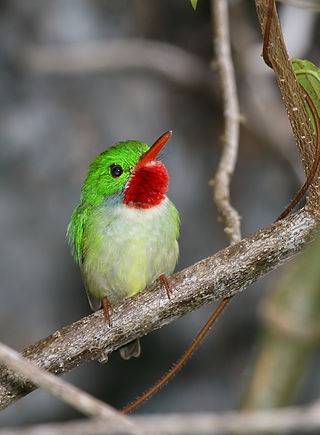
Todus is a genus of birds found in the Caribbean. It is the only genus within the todies family Todidae. The five species are small birds of the forests of the Greater Antilles: Puerto Rico, Jamaica, and Cuba, with adjacent islands, have one species each, and Hispaniola has two, the broad-billed tody in the lowlands and the narrow-billed tody in the highlands.

The Cuban tody is a bird species in the family Todidae that is restricted to Cuba and the adjacent islands.

The Jamaican tody is a species of bird in the genus Todus endemic to Jamaica. Local names for the Jamaican tody include rasta bird, robin and robin redbreast.
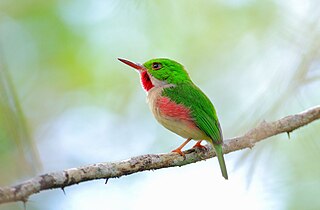
The broad-billed tody is a species of bird in the family Todidae, and one of two Todus species found on Hispaniola, along with the narrow-billed tody. They are small insectivorous birds, characterized by their bright green feathers, pink flanks and red throats.

The bay-breasted cuckoo is an Endangered species of bird in the tribe Phaenicophaeini, subfamily Cuculinae of the cuckoo family Cuculidae. It is endemic to the Dominican Republic on the Caribbean island of Hispaniola; it is possibly extirpated in Haiti.

The Antillean palm swift is a species of bird in subfamily Apodinae of the swift family Apodidae. It is found on the Caribbean islands of Cuba, Jamaica, and Hispaniola.
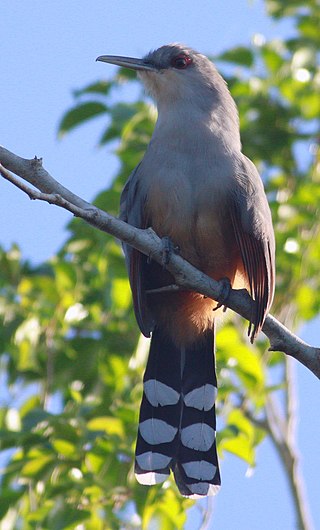
The Hispaniolan lizard cuckoo is a species of bird in the tribe Phaenicophaeini, subfamily Cuculinae of the cuckoo family Cuculidae. It is endemic to the island of Hispaniola that is shared by Haiti and the Dominican Republic.

The black-and-red broadbill is a species of bird in the typical broadbill family, Eurylaimidae. It is the only species in the genus Cymbirhynchus. A large, distinctive bird, it has maroon underparts, black upperparts, a maroon neck-band, and white bars on the wings. It also has a large, two-colored, blue-and-yellow bill. The species shows slight sexual dimorphism, with females being smaller than males. No other bird in its range resembles it, though the black-and-yellow broadbill has a similar call.

The grey-crowned palm-tanager or grey-crowned tanager is a Near Threatened species of bird in the family Phaenicophilidae, the Hispaniolan palm-tanagers. It is endemic to the Caribbean island of Hispaniola, in both the Dominican Republic and Haiti.
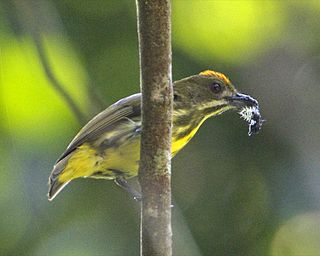
The yellow-breasted flowerpecker is a species of bird in the family Dicaeidae. It is found in Brunei, Indonesia, Malaysia, Myanmar, Singapore, and Thailand. Its natural habitats are subtropical or tropical moist lowland forest and subtropical or tropical moist montane forest.

The Hispaniolan spindalis is one of four species of bird in family Spindalidae. It is endemic to the Caribbean island of Hispaniola which is shared by Haiti and the Dominican Republic.
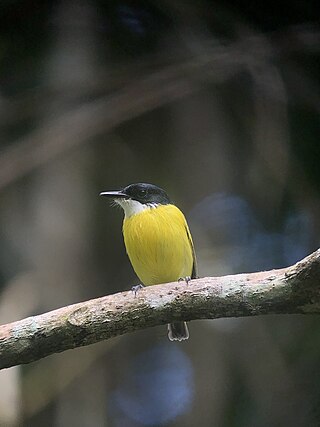
The black-headed tody-flycatcher is a species of bird in the family Tyrannidae. It is found in Colombia, Costa Rica, Ecuador, Panama, and Venezuela. Its natural habitat is subtropical or tropical moist lowland forests. It is a small, black and yellow, insectivorous bird.

The Antillean piculet is a species of bird in subfamily Picinae of the woodpecker family Picidae. It is endemic to the Caribbean island of Hispaniola that is shared by the Dominican Republic and Haiti.

The ivory-billed aracari or ivory-billed araçari is a near-passerine bird in the toucan family Ramphastidae. It is found in Brazil, Colombia, Ecuador, Peru, and Venezuela.

The brown-mandibled aracari is a near-passerine bird in the toucan family Ramphastidae. It is found in Bolivia, Brazil, and Peru.

The Hispaniolan trogon, also known as cacos is a species of bird in the family Trogonidae. It is endemic to Hispaniola in the Caribbean. It is one of the only two trogon species found in the Caribbean. It is the national bird of Haiti.





















